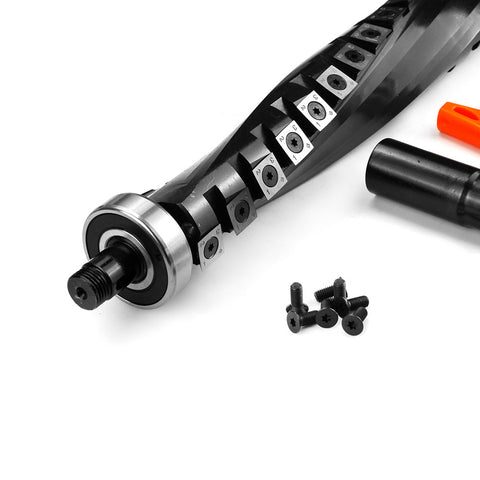
A straight cutterhead and a helical cutterhead are two different types of cutting heads used in woodworking machinery, particularly in planers and jointers.
A straight cutterhead, also known as a knife cutterhead, typically consists of multiple straight blades or knives that are mounted side by side along the cutterhead. As the cutterhead rotates, the straight blades make a straight cut into the wood, removing material in a straight line across the width of the workpiece. Straight cutterheads are simpler in design compared to helical cutterheads and are often more affordable. However, they may produce more noise and vibration during operation and can leave visible lines or marks on the workpiece.
Different between straight and helical cutterheads
Knowing the functions of straight cutterhead and helical cutterhead, here comes a question about how to choose the best cutterhead that can meet your needs. We take these two cutterhead into comparison in five aspects that you can take as a reference if you are confused.
- Cutting Mechanism:
Straight Cutterhead: A straight cutterhead typically consists of multiple straight blades or knives arranged side by side along the cutterhead. As the cutterhead rotates, the blades make a straight cut into the wood, removing material in a straight line across the width of the workpiece.
Helical Cutterhead: A helical cutterhead features multiple small, individual cutter inserts or blades that are arranged in a helical (spiral) pattern along the cutterhead. Each cutter insert has multiple cutting edges. As the cutterhead spins, the helical arrangement of the blades produces a slicing action, cutting into the wood at a slight angle.
- Cutting Quality:
Straight Cutterhead: A straight cutterhead provides a good surface finish on the workpiece, but it may leave visible lines or marks due to the straight knife edges. The cut quality can be influenced by factors such as the sharpness of the blades and the speed of the feed rate.
Helical Cutterhead: A helical cutterhead generally produces a superior surface finish compared to a straight cutterhead. The helical arrangement of the blades reduces the likelihood of visible lines or marks on the workpiece. Additionally, the multiple cutting edges of the individual inserts tend to reduce tear-out and produce cleaner cuts.
- Blade Maintenance and Replacement:
Straight Cutterhead: Maintaining and replacing blades in a straight cutterhead can be relatively straightforward. The straight blades are usually disposable and can be easily replaced or sharpened when necessary.
Helical Cutterhead: Maintaining a helical cutterhead involves individual cutter inserts that can be rotated or replaced as needed. Since each insert has multiple cutting edges, the overall lifespan of a helical cutterhead tends to be longer before requiring replacement or sharpening.
- Initial Cost:
Straight Cutterhead: Machines equipped with a straight cutterhead generally have a lower initial cost compared to those with a helical cutterhead.
Helical Cutterhead: Machines featuring a helical cutterhead typically have a higher initial cost due to the more complex construction and the cost of the individual cutter inserts.